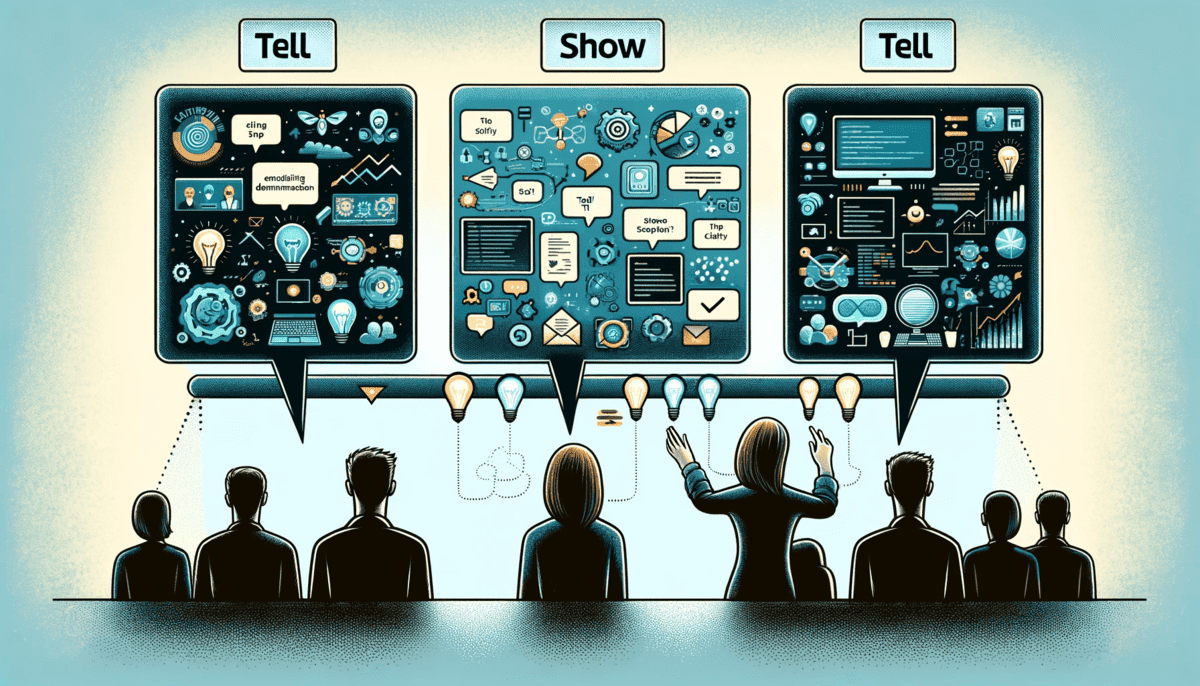Consensus and 2Win! Global Partnership: Revolutionizing Software Demos
In the rapidly evolving world of SaaS, delivering an outstanding buying experience is more crucial than ever. It's with great excitement that we...

The Streisand Effect is why you should stop telling the audience that your demo is broken, because all you’re doing is drawing more attention to the fact that your demo is broken.
The demo gods are fickle. Some days they’re on your side, and some days they’re not. We’ve all been there, up in front of an audience, giving a demo, when something breaks.
Who among us hasn’t uttered the phrase “the demo worked 5 minutes ago, I swear!”
Famously, this even happened to Bill Gates during a demo of Windows 98. While showing off how many USB devices at once Windows 98 could handle, the infamous BSOD (Blue Screen of Death) showed up. The audience had some fun with it, but the broken demo led to a bit of an awkward moment. Gates made a bit of a joke out of it: “That must be why we’re not shipping Windows 98 yet.” But the fact that I’m writing about this demo fail in 2022 shows the staying power of this particular BDOD appearance.
When something goes wrong with a demo, our inclination tends to be to call it out. To make an awkward joke and hope the audience doesn’t care. It’s like the old psychology saying “try not to think about a pink elephant,” and of course the first thing you think about is a pink elephant. Your broken demo isn’t all that different.
Here’s the bad news – that tactic never actually works.
Trying to distract the audience from the thing that’s broken in your demo only calls more attention to the thing that’s broken. This phenomenon – trying to keep people from focusing on something only makes them focus on it more – is known across the internet as “The Streisand Effect.”
The internet was very different back in 2003. Homestar Runner and eBaums World were in their prime. Sites were full of pictures of famous people wearing trucker hats and cargo pants. “Social media” (chat rooms/forums) was making fun of From Justin to Kelly.
Back then there was also a site (which is still around) called the California Coastal Records Project. That site contained pictures of (you guessed it), the California coastline – with the goal of documenting erosion over time.
While taking pictures for the coastal records project, Photographer Kenneth Adelman posted a picture that happened to contain Barbara Streisand’s house. Here’s the picture – note that, while her house is there, it’s relatively small and you can’t really see anything:

Somehow Barbara Streisand found out about it, and she got mad. Really mad. So mad that she sued Adelman and Pictopia for $50M claiming “violation of privacy.” No, that’s not a typo. She demanded fifty million US dollars, which is about $80M today.
Spoiler alert, Streisand lost, the case was dismissed, and she had to pay the defendants $177,107.54 in legal fees and court costs.
Had this lawsuit been filed by a non-celebrity, it wouldn’t have been a big deal. Maybe John Oliver would have made fun of it, but that’s likely as far as it would go.
But it was filed by a celebrity. In this case, Barbara Streisand, an EGOT (a winner of an Emmy, Grammy, Oscar and Tony award – even if her Tony was a lifetime achievement award vs a competitive one, it’s still quite the feat) tried to get $50M from a photographer. A photographer who was known for donating revenue from his coastline photography to an organization that protects said coastline. Needless to say, the press wasn’t kind to her.
Here’s the kicker: before Streisand filed the lawsuit, the image had been downloaded all of six times – two of which were her henchpeople lawyers. A month after the suit was filed, more than 420K people visited the site and saw the picture. Had she not drawn attention to this picture, no one would have seen it.
There’s an actual website called Urinal.net, and it “showcases the World’s largest collection of urinal photographs ever,” because the internet. One of the photos on that site was from a hotel on Marco Island in Florida called the Marco Beach Ocean Resort (you can probably guess where this is going).
Two years after Streisand’s lawsuit, the hotel sued urinal.net for simply having a post that used the hotel’s name. Writer Mike Masnick published an article about that suit on techdirt.com, and ended it with:
How long is it going to take before lawyers realize that the simple act of trying to repress something they don’t like online is likely to make it so that something that most people would never, ever see (like a photo of a urinal in some random beach resort) is now seen by many more people? Let’s call it the Streisand Effect.
The term “Streisand Effect” made its way to high-traffic sites like Forbes and Gawker (RIP), and is still in use today.
There are so many ways demos can break. It’s Murphy and his stupid law: whatever can break during a demo will break during a demo.
Sometimes demos break due to factors beyond our control. For example, the ops team took down your demo environment even though you specifically told them not to because of a big demo (this has happened to me more than once).
Sometimes it’s because of something within our control. We forget to reset a password. The application times out because we waited too long to show anything. There was something wonky in the data (technical term), etc. These things happen.
When a demo does inevitably break, presenters have a natural instinct to make a comment about it. They’ll typically do one of two things, either A) apologize or B) make a bad joke. And, like Barbara Streisand and her failed lawsuit, this only draws more attention to the thing that’s broken.
Remember in The Wizard of Oz, when the “Wizard” says the famous line “pay no attention to the man behind the curtain.” After he said that, what did Dorothy do? She immediately went to see what was up with the man behind the curtain, because of course she did.
“Pay no attention to the broken demo” leads to the same response from the audience. All they end up doing is paying attention to the broken demo.

When your demo breaks, look at The Streisand Effect as a cautionary tale. Instead of making comments about the broken demo, don’t say anything*.
I know, that sounds super simple – but it’s harder than it sounds. When something goes wrong, we get a bit of that shame response (more on that later, but for now, pick up some Brene Brown) and feel like we HAVE to say something. Because if we don’t, the audience will notice. Or will they?
Most of the time, they won’t. Musicians have a saying: play through the accidentals. This means that, unless it’s catastrophic, just pretend like you meant for it to happen. I’ve messed up solos on stage, broken strings, played in the wrong key – you name it. As long as I didn’t call attention to it, the audience never noticed.
So if it’s those little things that don’t severely impact the demo – little warning screens, forgetting to reset a setting, that sort of thing, just play through it. The audience will likely not notice, and if they notice, they likely won’t care.
If you’re in a team setting, I recommend having some sort of a cue with a teammate that means “please start talking so I can fix this.” That way, they can engage the audience in some way while you fix the broken demo. If you do this right, the audience won’t even notice that anything went wrong.
Even if they notice the error message, the good news is that most audiences will let little things go. That is, as long as you keep those things little by not talking about them.
*I’ll caveat this by saying this advice covers probably 80% of situations where the demo breaking isn’t catastrophic – if your demo completely fails and you can’t get it back, you’ll probably have to say something.
It’s 2022. High speed internet is not ubiquitous (which is a bigger problem for another time, but I’m looking at you FCC), but for those giving demos, there is likely a high-speed internet connection. And when Comcast inevitably fails, a mobile hotspot or cellular tablet is usually a good backup. Either way, “my internet is slow” doesn’t work the way it used to.
I’ve also seen “I’m going to go off camera to free up bandwidth.” That’s certainly something you can do, but beware, if that doesn’t fix anything, you’ll not only lose a bit of credibility, but your audience will likely go off camera (if they were on camera) as well – and they’re not coming back.
Speaking of things not to say, I recommend avoiding “well, it’s just a demo environment.” At that point, you’ve put doubt in the mind of your audience – “oh, the demo environment broke, huh? So is this entire thing fake? And if they can’t make their demo environment work, what will happen when we put this into production.”
All of these things tactics are going to be seen by the audience as a deflection, which, as we’ve learned by now, won’t work.
It bears repeating: the demo gods are fickle. A demo that worked 5 minutes ago might not work now. And a demo that was broken 5 minutes ago might suddenly work. But the more you try to get the audience to “pay no attention to the man behind the curtain” and not look at the thing that’s broken, the more attention they’re going to pay to the thing that’s broken.
When has The Streisand Effect impacted your demos? Let us know in the comments! And if you want to learn more about how to win deals even when your demo breaks, we should chat.

In the rapidly evolving world of SaaS, delivering an outstanding buying experience is more crucial than ever. It's with great excitement that we...

Transforming a good demo into a great demo is key to driving your deals forward. Here are 9 tips to transform your demos.

Tell-Show-Tell is one of the most powerful techniques a presenter can use in a software demo. This post is a conversation about Tell-Show-Tell...